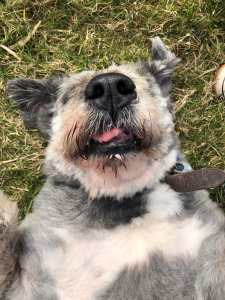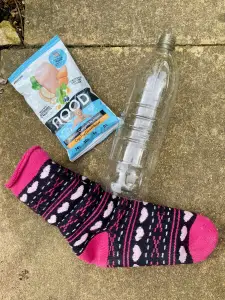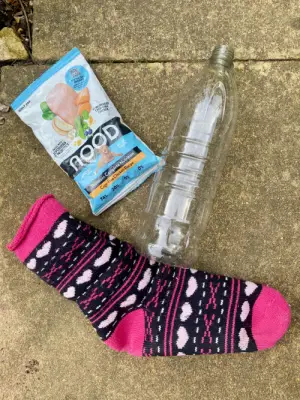Owning a puppy or dog isn’t about just feeding and walking. The additional responsibility of being a pet owner is creating a fun, happy and love-filled life.
We’ll look at ways to make DIY dog toys in low-cost ways to provide your furry friend with hours of entertainment, sensory stimulation and enrichment.
Understanding your dog’s needs

The natural instincts of dogs – Dogs are intelligent animals that have evolved from wolves. They have a strong instinct to investigate, learn, and adapt to their environment.
Challenges in a domestic setting – Many dogs today live in a domesticated setting, which can result in limited opportunities to exercise their natural instincts and abilities.
Signs of boredom and stress – Doggy boredom, frustration, and stress can manifest in various behavioural problems, such as excessive barking, destructive chewing, aggression, trigger stacking and depression.
You may be interested in the following articles:
- Cracking a Border Collie’s Behaviour – this can be useful for all breeds from puppyhood
- Notorious Behaviour of a Border Collie – the article shows real-life destruction!
- Trigger Stacking – stress and anxiety build up and peak at biting
The older rescue dog – Based on what I’ve seen, some older rescue dogs may have never experienced playing with toys or participating in activities like fetching a ball. Take Teddy, for instance. He is a Romanian rescue dog. He observed other dogs playing with balls on the beach and even tried to join in the fun by running around, but he never quite understood how to engage with the toys. To help Teddy grasp the concept of sensory stimulation first, he was introduced to various environments with different scents, sounds, and sights. And eventually, simple food games. Teddy and I holidayed in the North York Moors twice, and it provided amazing enrichment for him. My article, Me & Teddy: Our Chosen Dog-Friendly Holiday Cottage gives you an insight into a beautiful village with stunning views and the perfect location for dogs, or you can watch Teddy’s walking videos.
Dogs can learn from other dogs too so I would continue to lure your rescue dog into the world of fun toys!
Romanian rescue dogs come to the UK for a better life. You can read my articles about the adoption process and training an overseas rescue dog.
- Adopting a Romanian rescue Dog – You’ll see a picture of him living in a shack
- Training a Romanian Rescue Dog – Andreea adopted Roxy and helped her adjust
Visit Teddy on YouTube: Yorkshire walking videos, making a Teddy birthday cake and his transformation
The benefits of mental stimulation for a dog
Mental stimulation for dogs – Providing mental stimulation for your dog can prevent or reduce behavioural issues and enhance their cognitive functions.
Physical health benefits – Mental stimulation also improves your dog’s physical health by reducing stress, boosting the immune system, and promoting a healthy weight.
Emotional and social well-being – Besides physical and mental health benefits, mental stimulation enhances your dog’s emotional and social well-being by increasing happiness, strengthening the bond with you, and reducing loneliness. It forms a bond between the pet and the owner.
Stimulating senses – DIY toys with added material to formulate crunch and textures can stimulate your dog’s senses.
What can you use to make simple DIY dog toys?
You’ll be surprised what items in the home you can use to make homemade dog toys. Common household items such as old clothes, bottles, socks, cardboard, or crinkle paper are ideal for creating DIY dog toys. Do not use foil because it can cause discomfort against the teeth.
Crafting talent isn’t required either.
When you have a rescue dog like Teddy, who hasn’t learned how to play, it’s important to start with simple activities. Because Teddy came from Romania and food was scarce or was fought over, food-based games or tasks were the key. During our walks, we’d stop by the local pet shop or the pet section in the hardware store, and he’d get to pick out his treat, usually a dried pig ear. On special occasions, like his birthday, I made him a homemade cake, introducing him to different tastes and textures.
Watch the Video: Making a doggy birthday for Teddy – and his feedback!
How do you make homemade dog toys?

Bottle crunch toy
Make a crunch toy using an empty plastic bottle and an old sock. We all find ourselves with an odd sock because strangely, the washing machine eats them! Instead of throwing it away, use it to make a toy for your dog. This juice bottle is from Morrisons. Discard the lid and the plastic ring around the neck of the bottle – I used scissors to remove the ring. Fill with your dog’s favourite treats and place the bottle inside the sock.
I remember a special moment when Teddy played with an empty plastic bottle on the beach—it was truly remarkable to witness. As he chased after the bottle, he experienced the salty scent of the sea, the cool sensation of sand under his paws, and the joy of tossing the “toy” in the air and bounding after it. Eventually, he would settle down on the beach, gazing out at the vast sea or, during holidays, enjoying the view of the garden and hills, or observing the horses in the neighbouring field.
Watch the Video: Teddy’s North Yorkshire holiday cottage
Watch the Videos: Teddy’s walking trips around North Yorkshire
Clothing or fleece tug toy
Cut the fabric into strips and tie them together in one or several places. You’ll see in the video below that I used an old pyjama bottoms.
Watch the #Short: How to Make a Simple Tug Toy
Cardboard puzzle toy
Construct a puzzle toy using a cardboard box – for example, use your pet supply box from Zooplus! It’s simple to make.
1: Cut holes anywhere through the cardboard
2: Tape the box up to form the original shape
3: Using your dog’s favourite treats, push them through the hole. Use a box size suitable for the size of your dog
4: Your companion will pick up the scent of the food and have fun retrieving (and eating) the treats!
Fabric snuffle mat
Cut long strips of fabric or fleece and either stitch the middle section to an old towel or buy a heavy-duty doormat.
An example of the doormat is the 100% natural rubber mat from the Range. But check the Diall range from B&Q first as cheaper. Because of the holes, it’s easy to thread fabric through and tie. Once compacted, treats can be sprinkled and hidden around the strips, allowing for your dog to forage.
Alternatively, throw treats across the lawn and let your dog forage. At one point, Teddy did not have a lawn, so early weekend mornings, I’d throw treats across the patio. Some would roll behind a plant pot and he’d have to find them using scent.
Newspaper & treat foraging
Using newspaper sections, scrunch up the paper and then tuck treats inside. Re-scrunch and place around the house or garden for your dog to find.
How do you know what is the right toy for your dog?
Considerations of breed, size, personality and preferences are necessary when selecting or making DIY dog toys or general stimulation. Little dogs may prefer smaller, softer toys, that are more manageable for playtime and engagement. Larger dogs will require bigger and tougher toys.
Why does my dog get bored with toys so easily?
To stop boredom, rotate the toys regularly and enjoy playtime sessions with your dog in the garden. This weekend I enjoyed toy-throwing with my friend’s five dogs!
Another consideration is stepping up the level of difficulty with the toys you make. Canine challenges will keep your dog mentally stimulated.
Watch the videos: Teddy’s YouTube playlist
Watch the #Short: How to make a tug toy- coming soon
Are you supposed to wash dog toys?

Hygiene maintenance – Regularly wash your dog’s toys, or at least twice each month. Wash with mild soap and water, dry them thoroughly, and store them in a clean and dry place away from sunlight and moisture. However, this depends on the type of toy.
Repercussions of unclean toys – Dirty toys can harm your dog’s health because of bacterial growth, mildew from saliva or general dirt.
Disposal guidelines – Dispose of damaged toys promptly to ensure your dog’s safety and well-being.
Why are dog toys important for your dog?
Transforming playtime into an abundance of fun with DIY dog toys is a rewarding endeavour for both you and your furry friend. By incorporating mental stimulation into their play routines, you’re keeping them physically active and enhancing their cognitive well-being. From simple household items to creative crafting if more experienced, the possibilities are endless.
Overall, it strengthens your bond with your dog.
Key Takeaways:
- Use items you no longer want
- Consider using items you would normally throw into your recycle bin
- You don’t need to be a crafting genius to make toys
- Engaging play gives your dog lifelong enrichment
- Always rotate toys to prevent boredom
- Keep toys clean

